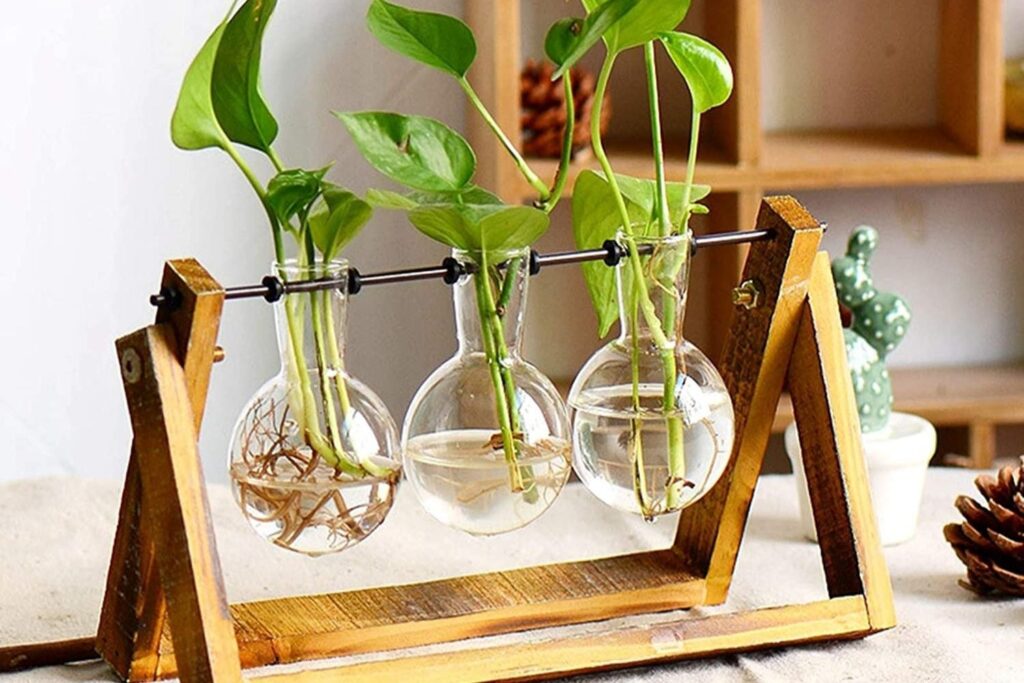If I told you that your plants could thrive without a speck of soil, would you believe me? Welcome to the world of hydroponics, where water-based nutrient solutions are the new garden gold. Hold on tight as we plunge into this riveting realm where, similar to Jack’s magical beanstalk, plants grow seemingly overnight with all their nutritional needs met not from below, but from above. No soil, no compost heaps, and staggeringly rapid growth rates – water-based nutrients solutions are not some sci-fi fantasy; they’re the reality for thousands of successful gardeners worldwide who’ve waved goodbye to dirt. You too can partake in this gardening revolution. Let’s see how.
Benefits of Water-Based Nutrient Solutions
Hydroponics has gained a lot of popularity in recent years due to its numerous benefits compared to traditional soil-based plant growth methods. One of the primary advantages of using water-based nutrient solutions for growing plants is that it offers improved control over plant growth. This means you get a consistent supply of nutrients, and you can make necessary adjustments to optimize plant growth based on environmental factors like temperature and humidity.
Using water-based nutrient solutions also executes better resource management by allowing to save water resources. Hydroponic systems use less water, up to 90% less, than traditional soil-based farming and are becoming popular in regions facing droughts or limited water resources. When grown hydroponically, crops’ roots only require enough water to take up nutrients, resulting in significant water savings.
Another benefit is higher yields compared to traditional soil-based systems. Hydroponic systems allow plants to grow faster by providing all necessary nutrients directly to the roots. As such, it eliminates random fluctuations in soil quality and pH that can hamstring traditional methods of farming. Also, lesser chance of pest infestation increases the yield drastically as well.
For instance, many commercial greenhouse growers have switched to hydroponic systems because they can produce up to six times more food than conventional farming techniques with smaller areas dedicated towards growing.
Additionally, hydroponics offer farmers greater flexibility when it comes to location since indoor setups can be established virtually anywhere without the need for extensive land or fertile soil and changing geographic regions does not impact yield production because the hydroponic environment remains consistent.
Some may argue that establishing a hydroponic setup requires financial backing which many small scale farmers lack. Furthermore, hydroponic setups are also generally associated with higher electricity bills due to a modernized control system that manages lighting and nutrient distribution.
However, reputable companies offer competitive prices for their products making it an affordable and growing option with an increasing number of small farms getting into the game. For example, the best hydroponic system as recommended by BitPonics is well under the $200 mark.
Like a visionary surgeon, hydroponic systems also give you the ability to have surgery on your plants, allowing you to cut off diseased or slightly damaged parts of a plant without affecting the rest of the plant. This is particularly important when it comes to sensitive plants like fruits and flowers. In traditional soil-based methods, cutting off diseased parts could potentially damage other close-by roots by creating an open wound in the soil for bacteria or other toxins to crawl in.

Conservation of Resources through Hydroponics
Water conservation is one of the main benefits of hydroponics setups. Traditional soil-based methods depend heavily on water usage and nutrient-rich soil conditions that require ongoing attention and enrichment. On the contrary, hydroponic setups utilise recirculation systems where water flows through a cycle that constantly provides nutrients to an entire crop, reducing water consumption considerably.
Furthermore, many nutrients can be reused in hydroponics setup since the plants absorb them directly rather than passing through underground layers before being accessed by crops lying above. This process results in lower chemical waste and fewer harmful runoff issues associated with traditional methods where excess water flushes away nutrients instead of being retained for future use.
Studies indicate that compared to soil-based farming/horticulture techniques, hydroponic farming systems with closed-loop units can help reduce up to 90 percent of freshwater consumption in agriculture-related activities.
The savings can translate into better yields as well since less time and energy are spent cooling crops from excessive heat caused by overly wet soil during hot and dry months.
The reduction in water usage also provides cost savings that can go towards better technology such as high-end LED lighting that uses less energy while providing much more significant yields during all seasons consistently.
The advantage of hydroponics is akin to having a water-efficient automobile, which requires less fuel and produces fewer emissions, saves money, and helps contribute to a cleaner, healthier environment.
Steps to Establish a Hydroponic System
Hydroponics systems are one of the best alternatives for growing plants since they use water-based nutrient solutions as a substitute for soil. With hydroponics, you can achieve optimum plant growth with less usage of resources such as water and fertilizers. Here is detailed guidance on how to set up your hydroponic system.
First, select a location that will optimize your setup. You may choose an indoor or outdoor location, but ensure that there is enough light for your plants. If you decide to grow indoors, you may need artificial lighting. A large room with enough ventilation is ideal if you want to grow numerous plants in different containers.
After selecting an appropriate location, choose the hydroponic system that suits your gardening needs. The most common hydroponic systems include deep-water culture (DWC), nutrient film technique (NFT), drip irrigation, ebb and flow hydroponics, and aeroponics. For instance, DWC is perfect for beginners; it’s cheap and straightforward to set up. Conversely, NFT specializes in growing smaller plants like lettuce.
Consider the nutrients required by your preferred plants before proceeding with the next step. An excellent analogy would be cooking; compared to making soup with water as a base, nutrients act as spices added into soup to give it flavor. In this regard, research what nutrient solution suits your preferred crop’s growth stage and adjust accordingly.
Selection of Suitable Plant Containers & Hydroponic Medium
The two essential components of your hydroponic system are the plant containers and the hydroponic medium (substrate). Among other things, these components support plant roots and hold them in place while accessing nutrients from the water-based solution.
Always consider the size of your plant during container selection. For example, a small plant requires a small container for optimal growth, while a larger plant needs more significant space to grow healthily. You can select containers made explicitly for hydroponics or regular household items such as plastic buckets. Always ensure that you drill holes into the bottom of each container before use.
The choice of the hydroponic medium depends on the type of plants being grown, availability, affordability, and personal preferences. Hydroponic mediums include rockwool, coconut coir, expanded clay pellets (hydroton), perlite, vermiculite, and sand.
A never-ending debate is that some growers prefer inert mediums that don’t affect nutrient content in their growth solution while others claim they like mediums with a high Cation Exchange Capacity (CEC). A substrate’s CEC allows it to hold onto nutrients better and release them gradually as required for your plant’s uptake.
With these two essential components in place, we move on to the next step – prepping nutrient solutions per plant type.

Preparing Nutrient Solutions Per Plant Type
One of the biggest advantages that hydroponic systems offer is the ability to customize nutrient solutions to fit the needs of different types of plants. Unlike soil-based systems, where nutrients can be lost due to runoff or improper drainage, hydroponic setups allow for precise control over the type and amount of nutrients supplied to plants.
When preparing a nutrient solution for a specific plant, it’s important to consider factors such as pH levels, required amounts of macronutrients (such as nitrogen, phosphorus, and potassium), as well as micronutrients (such as calcium, magnesium, and iron). Different plant species require varying amounts and combinations of these essential nutrients.
For instance, tomato plants prefer nutrient solutions that are higher in potassium, while lettuce requires more nitrogen. Similarly, strawberries thrive on moderate amounts of phosphorous and potassium. By understanding what specific nutrients each plant needs, growers can create custom-tailored nutrient solutions that maximize growth and yield.
To prepare these tailored solutions, growers must first identify the specific nutrient requirements for each target plant variety. This information can typically be found on seed packets or online growing forums. Once identified, growers can then follow guidelines provided by hydroponics experts or utilize software applications that recommend appropriate fertilizers based on plant type and stage of growth.
In creating the mixture itself, accuracy and precision are paramount. Commercial growers will often invest in specialized mixing equipment to ensure exact measurements are achieved every time. However, for smaller-scale setups at home, digital scales and measuring cups can provide sufficient accuracy when working with small volumes.
With careful attention to detail and adherence to recommended amounts of solution concentrations per individual plant species, hydroponic gardeners can expect great success in their harvests year-round.
While providing tailored nutrient solutions for plants is important for optimal growth results, ensuring that the solution is properly balanced is equally crucial in achieving maximum growth rates.
Balancing Nutrient Solution for Optimal Growth
At a fundamental level, all hydroponic nutrient solutions can be broken down into three primary components: nitrogen (N), phosphorus (P), and potassium (K). These macronutrients, also known as NPK, form the backbone of any successful hydroponic operation. The relative amounts of each nutrient can be adjusted depending on the individual requirements of specific plant species, to achieve optimal results.
While it may be tempting to add more of one particular nutrient to achieve better growth, growers should take care to maintain a well-balanced nutrient solution. Over-fertilization with excess nutrients can lead to problems such as reduced yields and poor fruit quality.
For example, too much nitrogen will result in lush green top-growth but fewer fruits or flowers. On the other hand, potassium deficiency will cause yellowing leaves and weak stems.
Many commercial fertilizers sold for hydroponic gardening now come complete with a full range of micro-nutrients to help prevent these issues. Of course, mix-it-yourself growers may have to source these nutrients through alternate means or supplements like fish emulsion or bone meal.
To balance nutrient solutions effectively, home growers should pay attention to pH levels. Each plant variety has an optimal pH range within which they can absorb nutrients most effectively. Hydroponic systems generally prefer slightly acidic nutrient solutions ranging between 5.5 and 6.5 pH levels.
In many ways, preparing and maintaining a well-balanced hydroponic system is like operating a finely tuned sports machine. Just like how each athlete requires specific nutrition and training programs according to their sport and physical needs, each plant species has unique nutritional requirements that need careful consideration during the growing process.
With careful attention to balancing the nutrient solution and keeping pH levels steady, growers can maintain healthy, happy plants that grow strong and produce bountiful crops.






